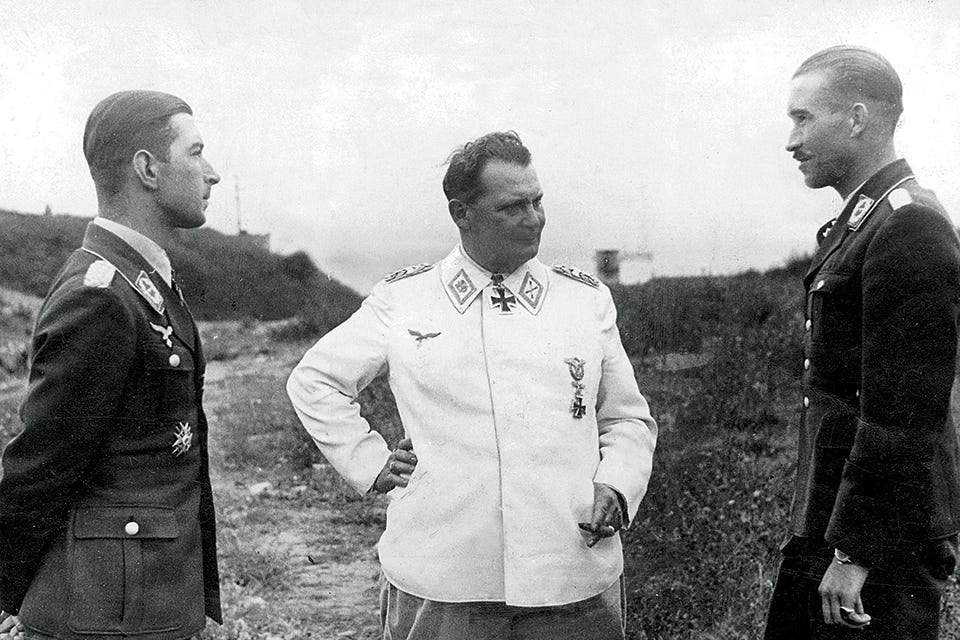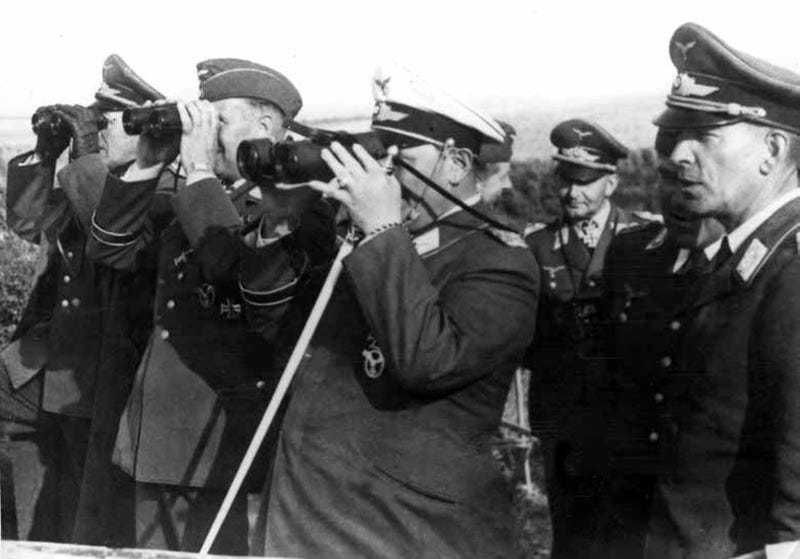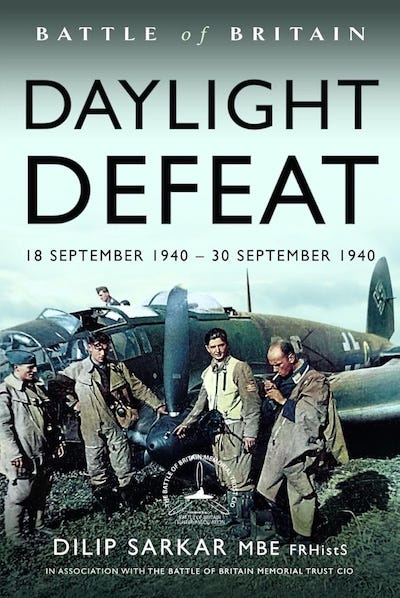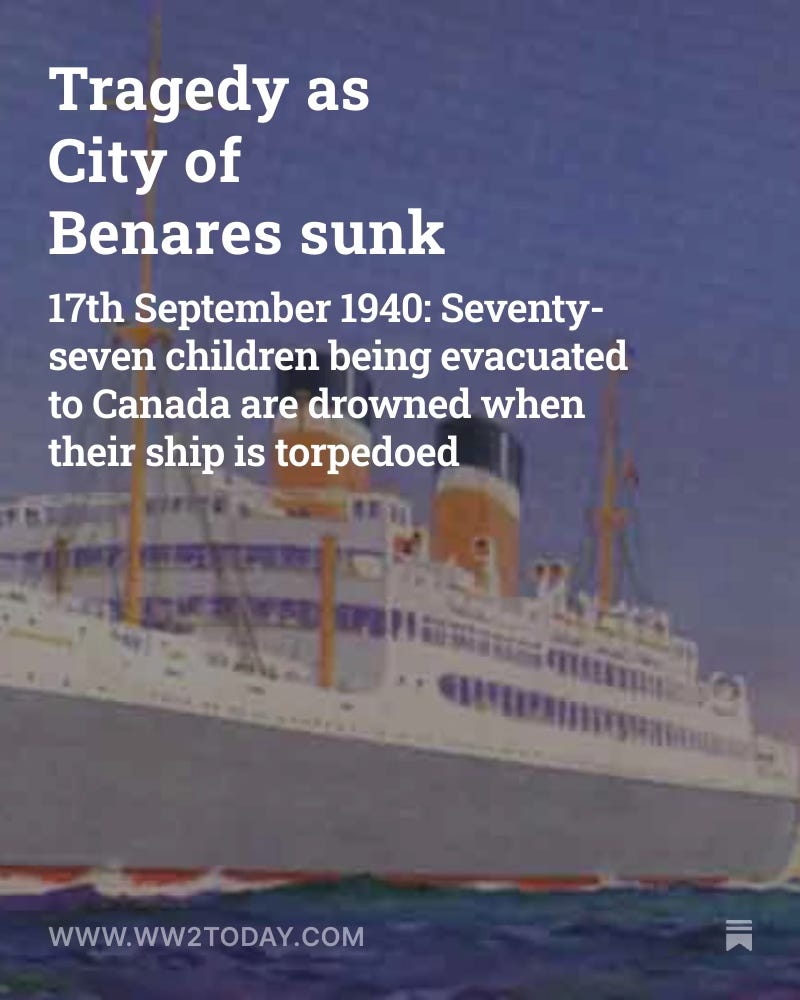Luftwaffe change tactics again
20th September 1940: Hermann Göring orders the use of 'Jabos' - fighter bombers to try to entice the RAF into battle
On 17th September, Adolf Hitler had reconciled himself to the fact that the Luftwaffe would not defeat the RAF and Operation Sealion, the invasion of England, was postponed indefinitely. Some preparations continued, for the sake of putting pressure on Britain, but the invasion barges, so hurriedly assembled, were soon dispersed. There was the possibility of resurrecting the plans in the following Spring - but Hitler’s focus was already shifting to an attack on Russia.
The Reichsmarschall had not given up, however. Hermann Goering still believed the intelligence that the RAF was nearly broken. He now sought further tactical changes that would force the RAF fighters to join battle.
In this excerpt from the sixth volume of Dilip Sarkar’s history of the Battle of Britain, Battle of Britain Daylight Defeat: 18 September 1940 - 30 September 1940, the overall tactical situation is considered alongside the day-by-day personal stories of the fighter pilots:
Friday, 20 September 1940
A significant advantage enjoyed by the German fighter pilots was the ability to climb to combat altitude before reaching England. Pilot Officer Geoffrey Wellum of Biggin Hill’s 92 Squadron remembered that
During September and October 1940 the 109s were always active in the Biggin Hill Sector, and caused problems. I recall that they were always above us as we never seemed to be scrambled in time to get enough height. Our climb was always a desperate, full-throttle affair, but we never quite got up to them. I did manage to get a crack at two Me 109s on one patrol, but although I saw strikes I could only claim them as damaged.
The enemy’s free roving and high-altitude fighter sweeps were certainly effective – but could be ignored. RDF [Radio Direction Finding], whilst providing essential advance warning of likely enemy numbers and direction of travel towards the British coast, was unable to identify whether approaching enemy formations comprised bombers or fighters, or both. Moreover, RDF, at the time, was only outward looking, and of no help, therefore, once the Germans had crossed the coast.
It was then that the eyes and ears of the Observer Corps, and other visual sightings, became invaluable. Fighter sweeps, if identified as such, could be ignored, because these were only dangerous if engaged by RAF fighters – which was, of course, what the Germans wanted. Far better, then, for the defenders to ignore these incursions and watch the enemy waste time and fuel. This, though, now led to a sudden change in Luftwaffe tactics.
To ensure a reaction from the defenders, Reichsmarschall Hermann Göring ordered that one Staffel in every Gruppe would become fighter-bombers – Jabos. This, however, affected one third of his available fighter force, and was an unpopular decision with senior fighter leaders already lacking the resources necessary to achieve aerial superiority. For so long, auxiliary fuel tanks had been requested, to extend range, but instead bombs arrived. The tactical thinking behind this order was that if German formations included Jabos, the RAF would have to consider every sweep a potential threat and respond to it – sound in theory but not when resources were so limited.

Major Adolf Galland, Kommodore of JG 26:
The fighter-bombers were put into action in so great a hurry that there was hardly any time to give the pilots bombing training, and most of them dropped their first bomb in a raid on London or on other targets in England. We had a total of 250 fighter-bombers. The Me 109 carried a 500lb High Explosive bomb … No great effect could be achieved with that … the fighter pilots were ‘browned off ’ with carrying cargo and glad to get rid of their bombs anywhere.
The fighter-bomber raids were carried out in the following way: each gruppe [sic] escorted its own bombers. The approach altitude was about 18,000 feet. At the start, we let the fighter-bombers fly in bomber formation, but it was soon apparent that the enemy fighters could concentrate fully on the bombers, so we distributed them in small units throughout the entire formation and thus brought them fairly safe over their target area. This type of raid had no more than nuisance value.
The passive behaviour towards enemy fighters, the feeling of inferiority when we attacked, because of loss of speed, manoeuvrability and rate of climb, added to the unconvincing effect of single bombs scattered over wide areas, combined to ruin the morale of the German fighter pilot, already low because of the type of escorting that had previously had to be undertaken. Suffice it to say that the Jagdwaffe was bitterly critical of the OKL over this move.
The first ‘tip n’ run’ raid, as they widely became known, occurred this day, when twenty-two II/LG 2 fighter-bombers, protected by numerous fighters of JG 2, 3, 26, 27, 51 and 53, attacked London. The Jabos crossed the English coast at 25,000ft, making the intrusion appear to be a fighter sweep, then descended to 12,000ft.
Not knowing of the enemy’s new plan, the RAF controllers did not react at first and were surprised when bombs were suddenly dropped indiscriminately on the capital. Having dropped their bombs, the fighter-bombers returned to France, unchallenged by the defenders. Meanwhile, the escorting Me 109s still lurked over south-east England, unfettered now by escort duties and able to hunt freely.
Thirteen Spitfires of 222 and 603 Squadrons scrambled from Hornchurch at 10.55 hrs with orders to patrol base at 20,000ft. From on high, the British fighters were spotted by Galland – a deadly adversary indeed.
Sergeant Reg Johnson of 222 Squadron’s ‘B’ Flight:
Our Blue Section was led by Pilot Officer John Broadhurst, followed by Pilot Officer [Herbert Laurence] Laurie Whitbread, myself and one other in Green Section. We climbed to the suicidal height of 14,000 feet and stooged around in tight vic formation with only one pair of eyes available to scan the sky in front, perhaps over 200°. I do not think that we deserved to be jumped, but we certainly invited it. We were banking gently to the left, which allowed me at No 3 to look over the top of No 1, and I shouted the warning ‘Bandits, 2 o’ clock above – attacking!’
I turned over and dived straight down. There is no way that Pilot Officer Whitbread could even have seen the enemy, formating as he was on the aircraft to his left and with three-quarters of his head and back to the attackers. When I left it was his right side facing the 109s, which were already in firing range. I can only assume that having received my warning he too rolled to his right, exposing his left side to the enemy and was hit before he could commence his dive. It was a tragedy.
According to the official report, over Rochester 222 Squadron’s ‘B’ Flight was attacked from above by thirty Me 109s, Pilot Officer Herbert Laurence Whitbread being singled out and shot down by Galland himself. Mortally wounded, the 26-year-old Ludlovian managed to crash-land his Spitfire, skidding across Hermitage Road, Higham, the wrecked aircraft coming to rest in a stagnant pond. The pilot, however, was somehow thrown clear and found dead.
Ludlow is a picturesque market town in Shropshire, and ‘Laurie’ was the small community’s first fatal casualty of the Second World War. When writing to his bereaved parents on 3 October 1940, 222 Squadron’s CO, Squadron Leader John Hill, spared them the actual details, stating that
He was killed instantly by a bullet from an enemy aircraft when doing his bit in defence of his country. His passing is a great loss to us; he had been in the squadron since its formation and was always most popular, having a quiet and efficient disposition and charming manner.
Indeed, Johnson recalled the young officer as
a very brave young man of the highest quality. Naturally courageous, he was always prepared to give his life for his country, but it was taken away from him due to the practice of unsatisfactory tactics.
Pilot Officer Herbert Laurence Whitbread was buried in the cemetery at Ludlow, his old master at the local grammar school, George Merchant, later wrote that afterwards
we turned and went back and left him alone in his glory, with his name and rank on the gravestone and the proud badge of the RAF which he had carried through peril to the stars … He was the kind of boy you noticed first and remembered afterwards if you saw him talking in a group of his fellows, though he was probably saying less than any of the others. He was the kind of boy one does not forget and is glad to have known.
© Dilip Sarkar 2025, 'Battle of Britain Daylight Defeat: 18 September 1940 - 30 September 1940'. Reproduced courtesy of Pen & Sword Publishers Ltd.






